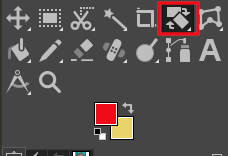
To do this, use Image Transform Rotate 90 clockwise (or counter-clockwise). If you are having a different issue, they won't help. Images that are taken with digital cameras sometimes need to be rotated.
#Gimp rotate how to
It takes effect the next time you open or import a JPEG file.īoth of those work, but only for the specific case I have described. Hi there Terry Smith here and Im going to show you how to rotate an image in gimp first thing were going to want to do is hit up our image tab from here we.

There, you can set the rotation axis, marked with a point, and the rotation angle. When you click on the image or the selection with this tool a Rotation adjustment dialog is opened. Or, you can copy the command I gave above - parenthesis and all - into the script-fu console and press Enter to execute it. Overview This tool is used to rotate the active layer, a selection or a path. If you chose to do either of these, do it while GIMP is not running. To clear the setting and have GIMP ask you again about importing JPEG files which have EXIF rotation tags, you can either delete that "parasiterc" file (possibly losing other preferences too, but not your main GIMP settings), or edit it to remove the exif-orientation-rotate action.
#Gimp rotate windows
It's somewhere else on Windows and Mac, probably. GIMP calls this setting a "parasite" (possibly because it is attached to a plug-in, the JPEG importer) and stores it in a file called "parasiterc" in your GIMP preferences directory, which is ~/.gimp-2.8 on my system. There is no way in the user interface to undo "don't ask me again", it seems. If you check this box, then pick Keep or Rotate, GIMP will do what you say when importing this image, and all future JPEG images, without asking. There is also a check-box "Don't ask me again". Would you like GIMP to rotate it into the standard orientation?" (This happens if I shoot in portrait mode - camera rotated 90 degrees - using a camera with a built-in orientation sensor.) GIMP displays a dialog: "According to the EXIF data, this image is rotated. Then look for Main Mouse Wheel,click on it and you get a list of 'Events'Ĭhoose one, say Scroll Up Click on that and you get a list of possible actions.The fix I posted 2 years ago here is for a very specific case: You open a JPEG file in GIMP, and the JPEG file has EXIF tags that say the photo was taken rotated.

Open Edit -> Preferences -> Input Devices -> Input Controllers The really important and clever one is 'Transform Direction'. Looks complicated but very straight forward. This tool has a bunch of options, most of which you can ignore. However for the mouse scroll wheel, the procedure is the same as for brush size see: Most of the keyboard is already taken up with shortcuts, but you can re-assign a pair of keys Edit -> Keyboard Shortcuts example (a good example of the rubbish dark theme) How do I bind AND use then activate a keyboard (or mouse wheel) shortcut that allows me to rotate a custom brush so that I do not have to constantly go back and forth with a slider to make micro-adjustments? We can activate this tool by navigating through Tools-> Transform Tools-> Rotate menu or by just hitting the ' SHIFT+R ' keys. but each and every tutorial / help page, gives basically the same answer. The rotate tool in GIMP is used to rotate the objects these objects can be a selection, image, layer, or any other image component. distortion to an image by providing three rotation angles, zoom, offsets. (01-06-2022, 03:41 PM)kmkenpo Wrote: I am sorry if this is something that I should be able to easily find on the net. the front and left or right side of box viewed in rotated perspective. To adjust the angle, you can type or change the values or use the slider to rotate the image based on the angle.


 0 kommentar(er)
0 kommentar(er)
